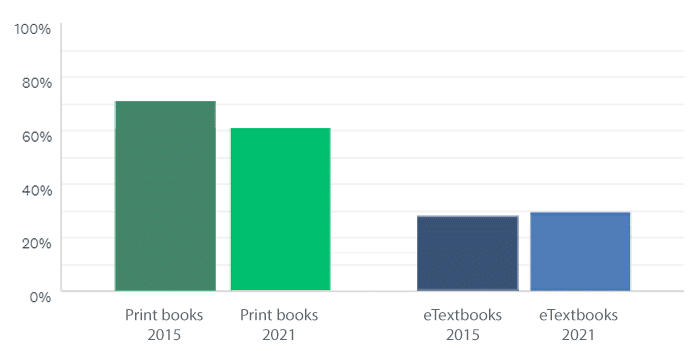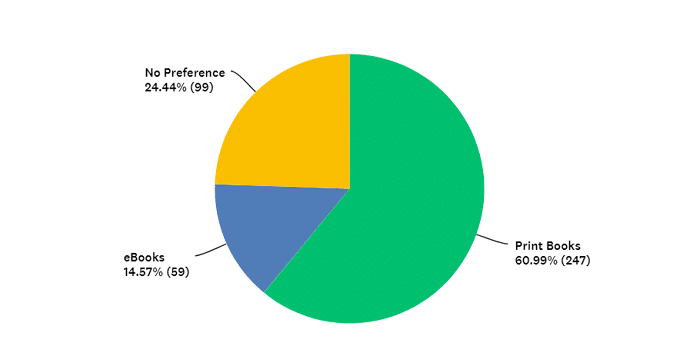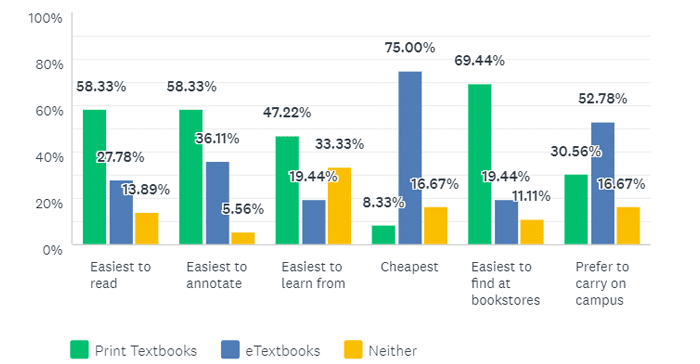Despite the growing eTextbook market, six out of ten college students prefer print textbooks for academic learning. Direct Textbook surveyed more than 400 active college students and found:
- 62% of students prefer print textbooks to eTextbooks
- 29% prefer eTextbooks
- 9% have no preference
STUDENT TEXTBOOK PREFERENCE: ACADEMIC LEARNING

That represents a 10% decline in print textbook preference since 2015, when 72% of students reported favoring print textbooks, but it doesn’t mean students are embracing eTextbooks.
In fact, student preference for eTextbooks increased by just 2% from 2015 (27%) to 2021 (29%), while the number of students who have no preference increased by nearly 8% over that same period.
TEXTBOOK FORMAT PREFERENCE: 2015 VS 2021

| “Print books can be read anywhere and at any time, and it’s much easier to find information. I can always go back to a print book even after 5 years for reference, but the ebook will disappear right after class is over.” – Surveyed College Student |
Similarly, 61% of students prefer print books for recreational reading, while 15% prefer ebooks and 24% have no preference.
STUDENT BOOK PREFERENCE: RECREATIONAL READING

| “I think I have trouble focusing on eTextbooks because when I’m on my devices, my brain is conditioned to think that it’s time for play rather than studying.” – Surveyed College Student |
Students who prefer print textbooks cite the following reasons:
- Print textbooks are easier to read (78%)
- Difficulty concentrating on eTextbooks (63%)
- The ability to physically highlight passages (61%)
- Internet access is not required (51%)
- eTextbooks are difficult to navigate and bookmark (50%)
- eTextbooks make students’ eyes hurt (44%)
- The ability to write on pages (35%)
- The ability to resell print textbooks (31%)
- They end up printing eTextbook pages anyway (25%)
| “I prefer physical books because the eTextbooks do not always match the original book or have access to extra study portals or links.” – Surveyed College Student |
Students who prefer eTextbooks over print textbooks cite the following reasons:
- The ability to find passages with search features (88%)
- eTextbooks are environmentally friendly (70%)
- eTextbooks are cheaper (69%)
- The ability to adjust font size and brightness (66%)
- eTextbooks are lighter (57%)
- eTextbooks do not need returned (56%)
- Text to audio features (53%)
- The ability to use apps with eTextbooks (32%)
| “I can take eTextbooks anywhere. They are always with me.” – Surveyed College Student “I can create my own study sheets from eTextbooks.” – Surveyed College Student “I often print the pages from my eTextbooks. The ability to print and do text to voice audio is very important to me. If the ebook does not have print options, then I would prefer the printed book.” – Surveyed College Student |
Insights from students who have no preference include:
- 58% say print textbooks are easier to read and annotate
- 47% say print textbooks are easier to learn from
- 69% say print textbooks are easier to find at bookstores
- 75% say eTextbooks are cheaper
- 53% say they prefer to carry eTextbooks on campus
STUDENTS WHO DO NOT HAVE A PREFERRED TEXTBOOK FORMAT

| “I compromise and use eTextbooks for subjects that I do not find as challenging or text necessary like writing and social sciences, but I greatly value the physical book for intensive subjects such as math and science.” – Surveyed College Student “I like both – when the textbook provides an online access code. I like to use my printed copy at home and highlight it and annotate freely, then use my eTextbook if I’m on campus or studying elsewhere.” – Surveyed College Student “eTextbooks have no salvage value, and you don’t have to get rid of them. I think eTextbooks should be much cheaper than print books… but so far, the discounts aren’t significant.” – Surveyed College Student |
The eTextbook market continues to grow despite student preference for print textbooks. According to Student Monitor, eTextbooks represented 20% of average student textbook purchases in 2020, up from 9% in 2015 (Inside Higher Ed).
Many students say they would switch from one textbook format to the other if the alternative format was cheaper. Direct Textbook is a free service that instantly compares prices from more than 200 bookstores to help students save up to 90% on textbooks. Start your search.